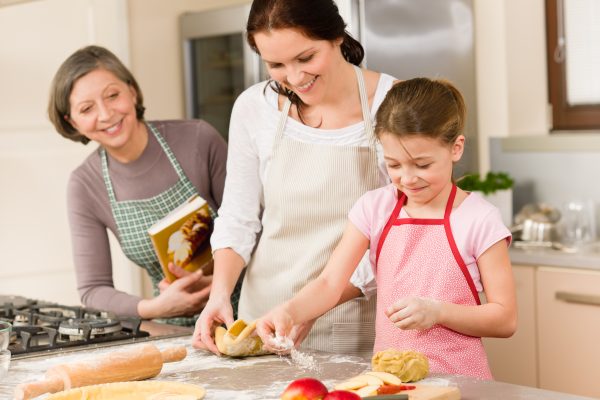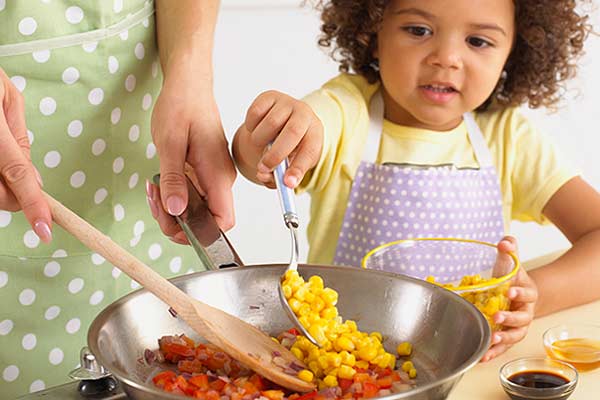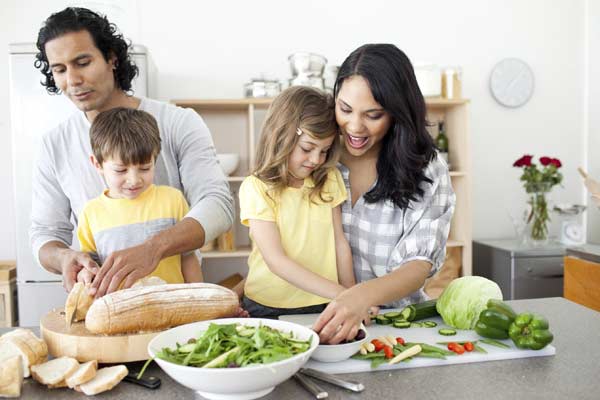The dreaded dinnertime dilemma: You suddenly realize that it’s just after five o’clock and it’s time to make dinner…again! Wouldn’t it be nice to have someone else to take over the dinner preparations, or at least lend a hand from time to time? Look no further than your own children. Your toddler might not be able to pull of a three-course meal, but she can certainly help bring things to you and set the table.
Kids are always eager to learn and help, but so often we push them aside–even plopping them in front of the television–so that we can get a meal on the table without having to listen to a “drum” solo on the pots and pans, clean up extra spills because their hand-eye coordination needs more practice, make an impromptu double batch of the casserole because she accidentally put in the whole package of noodles instead of half. By taking time to embrace these teachable moments and minds, it’s possible to get kids familiar with the kitchen and basic skills from an early age.
Just as with reading, piano and soccer, with repeated practice their skills will develop and by the time they’re pre-teens they can easily cook dinner one night a month.
Safety First!
Just because toddlers can’t learn the proper way to handle a knife doesn’t mean that they should. Use common sense, and err on the side of caution, when deciding which skills you’ll teach the kids.
Younger kids can:
- measure dry ingredients like sugar, flour, beans
- pour milk, oil, water and broth into pans
- stir ingredients together
- break eggs (into a separate bowl to avoid a crunchy calcium boost to your food)
- unwrap butter, cheese and cream cheese
- wash fruits and vegetables
- press granola bars into a pan
- toast bread and bagels
- spread jam, butter and peanut butter with a plastic knife
- mash potatoes, bananas and cooked apples
- use cookie cutters
- press garlic
Older kids can:
- peel vegetables
- open canned goods
- cut fruits and vegetables
- grate cheese
- slice vegetables
- use specialty appliances like blenders, waffle makers and panini presses
- follow written recipes
- microwave food
- use the stove and oven
Sanitation Skills
Set a good example by pulling or pinning your hair back, putting on an apron and washing your hands thoroughly as you start each cooking session. Explain each step as you do it, rather than lecture them, and invite them to do it with you. If they choose not to, let them know that the cooking can’t commence until they’ve completed these steps. These reminders will be frequent at first, but over time donning an apron and washing their hands before cooking will become second nature.
Nutritious Nibbles
Make your first foray into cooking with the kids relatively simple and create a snack that they’ll enjoy. Some kid-friendly favorites include:
Apple Slices with Nutty Dip- Wash or peel and apple and cut it into slices. Stir together 1 cup of peanut (or other nut) butter with 8 ounces of softened cream cheese. Either dip apples or spread the dip on top of each slice.
Loaded Bagels- Toast or microwave bagels and spread with cream cheese. For fruity bagels, top with chopped strawberries and bananas, blueberries and shredded coconut. Or try veggies like colored bell pepper pieces, chopped broccoli and shredded carrots.
Berry Green Smoothies- Fill the blender with a generous handful of spinach, a banana, two cups of frozen strawberries or an assorted berry blend. Add enough milk or yogurt to blend to the desired thickness.
Expand Their Knowledge and Their Vocabulary
Experts say that kids who are active in preparing the family’s meals tend to eat healthier. Cooking with the kids is a great time to casually discuss nutrition since you’re not competing with television commercials beckoning your kids to eat sugary-packaged snacks or magazine ads touting the newest corn syrup-laden fruit beverages that will have the kids running on high-speed all night long.
Talk about the importance of eating a balanced diet; fresh fruits rather than fruit snacks; the virtues of a heartily topped baked potato over nutrient-void potato chips.
If your family follows a way of eating that’s not mainstream–vegetarian, vegan, gluten-free, Paleo–this is a prime opportunity to educate your kids about your way of eating.
Take the kids grocery shopping and let them choose new-to-them fruits and vegetables. At home hop on Google to find a recipe and prepare it for dinner. Kids who are given choices in meal planning, do they want vegetable soup or chili for dinner, are often more willing to eat the foods since they feel they’ve been given some control.
When cooking use the names of the tools as you use them. Show them the difference between ‘whisk’ and ‘stir’ as you make cookies. First you whisk the eggs with the sugar, then you slowly stir in the flour. They probably won’t remember the words the first time, but heard repeatedly during regular cooking sessions, they’ll internalize the words and start using them when appropriate.
Have Fun
Most of all, don’t stress over these cooking sessions. Enjoy your time cooking with kids! Making memories and teaching them in an inconspicuous way and over time they’ll develop a vast array of skills. What are some ways that you include your kids in cooking? Share your tips in the comments!
If your child enjoys cooking, consider some of these summer camps for your little culinary geniuses!
Cooking Camp for Tweens and Teens – Palo Alto, CA



















